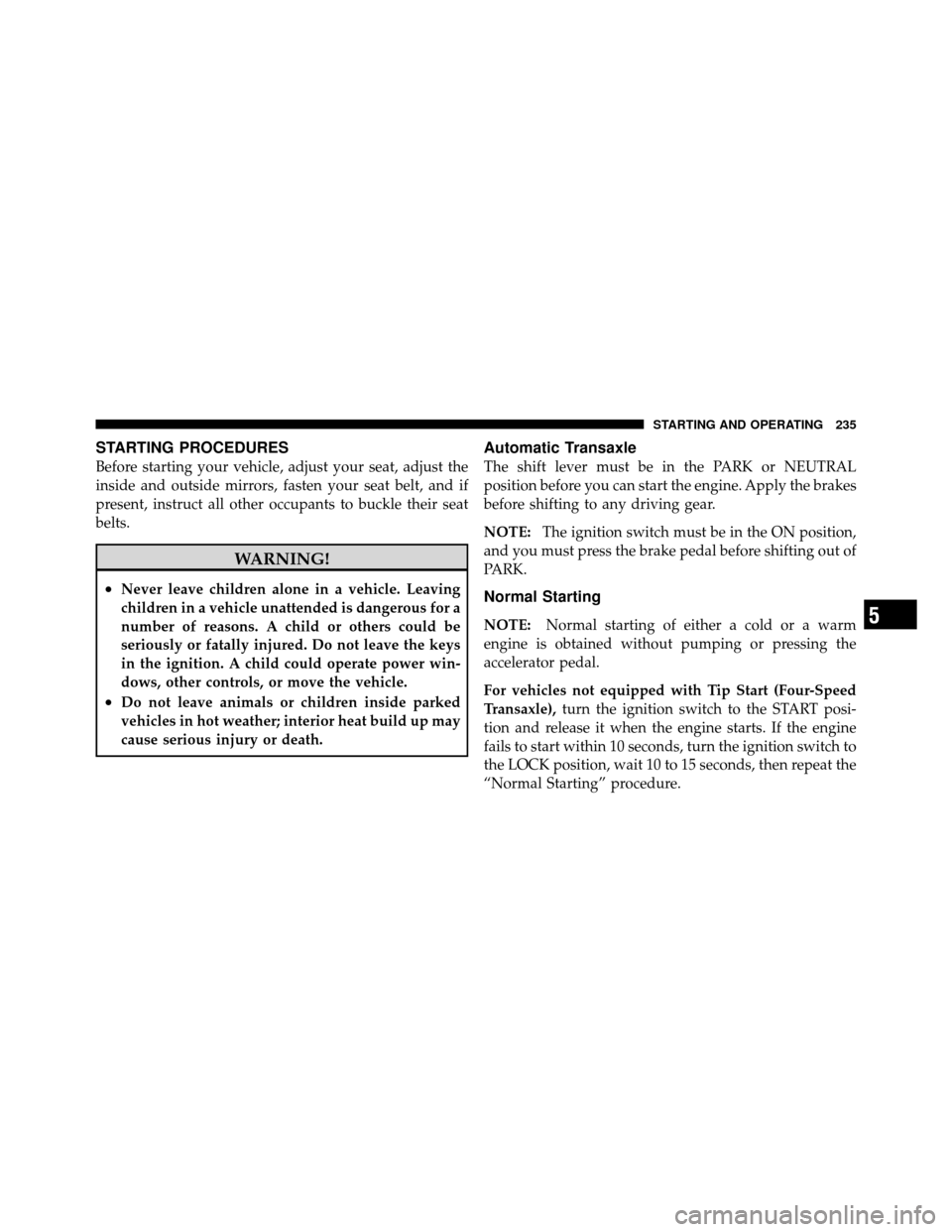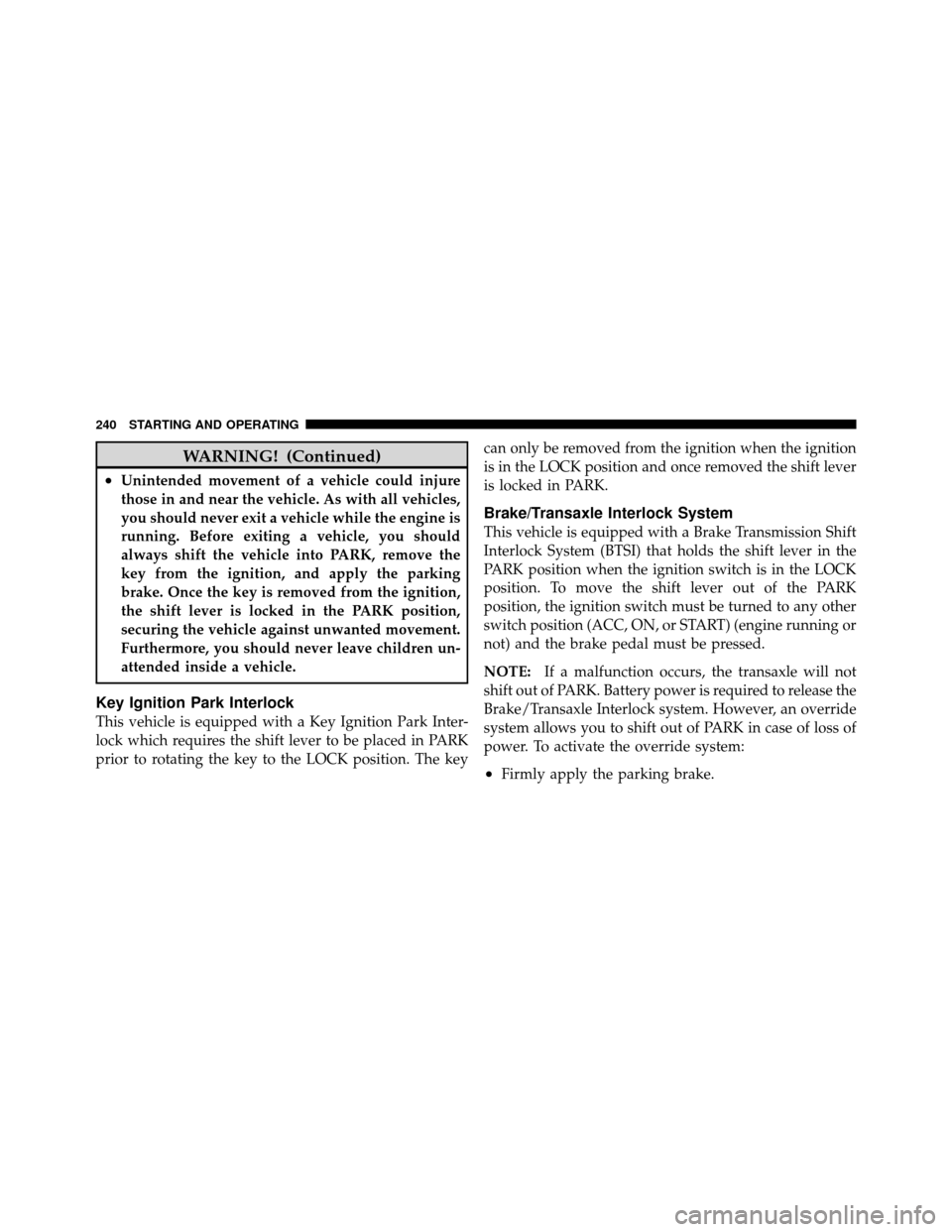Page 153 of 436

16. Odometer/Trip Odometer Reset Button
Single Trip Odometer
Press and release this button to change the display from
odometer to trip odometer. The word “Trip” displays to
show that the odometer is in Trip Mode. Press and release
the button again to change the display back to the
odometer.
To reset the trip odometer, first set the display to Trip
Mode. Then push and hold the button (approximately
2 seconds) until the display resets to 0 miles (km). The
odometer must be in Trip Mode to reset the trip odom-
eter.
Dual Trip Odometer — If Equipped
Press and release this button to change the display from
odometer to “Trip A.” Press and release it a second time
to change the display to “Trip B.” Press and release it a
third time to change the display back to the odometer.To reset the trip odometer, first display the trip mileage
that you want to reset, “Trip A” or “Trip B.” Then push
and hold the button (approximately 2 seconds) until the
display resets to 0 miles (km). The odometer must be in
Trip Mode to reset the trip odometer.
17. Electronic Throttle Control (ETC) Indicator Light
This light informs you of a problem with the
Electronic Throttle Control (ETC) system. If a
problem is detected, the light will come on
while the engine is running. If the light remains
lit with the engine running, your vehicle will usually be
drivable and not need towing, however see your autho-
rized dealer for service as soon as possible.
If the light is flashing when the engine is running you
may experience power loss, an elevated/rough idle, and
increased brake pedal effort, and your vehicle may
require towing. Immediate service is required.
4
UNDERSTANDING YOUR INSTRUMENT PANEL 153
Page 154 of 436

The light will come on when the ignition switch is first
turned on and remain on approximately 15 seconds as a
bulb check. This is normal. If the light does not come on
during starting, have the system checked by an autho-
rized dealer.
18. Position Light Indicator — If EquippedThis indicator will illuminate when the park
lights or headlights are turned on.
19. Electronic Stability Control (ESC) OFF Indicator
Light — If Equipped This light indicates the Electronic Stability Con-
trol system (ESC) has been turned off by the
driver.
20. Turn Signal Indicators The arrows will flash in unison with the exterior
turn signal, when using the turn signal lever. 21. Front Fog Light Indicator — If Equipped
This indicator will illuminate when the front fog
lights are on.
22. Vehicle Security Light — If Equipped This light will flash rapidly for approximately
16 seconds when the alarm system is arming.
The light will begin to flash slowly indicating
that the system is armed. The light will stop
flashing when the vehicle is disarmed.
23. Anti-Lock Brake (ABS) Light — If Equipped This light monitors the ABS. This light will
come on when the ignition key is turned to the
ON position and may stay on for approxi-
mately three seconds.
If the ABS light remains on or comes on during driving,
it indicates that the Anti-Lock portion of the brake system
is not functioning and that service is required, however,
154 UNDERSTANDING YOUR INSTRUMENT PANEL
Page 155 of 436

the conventional brake system will continue to operate
normally provided that the BRAKE warning light is not
on.
If the ABS light is on, the brake system should be serviced
as soon as possible to restore the benefit of Anti-Lock
Brakes.
The ABS warning light should be checked frequently to
assure that it is operating properly. Turn the ignition key
to the on position, but do not start the vehicle. The light
should come on. If the light does not come on, have the
system inspected by an authorized dealer.
24. Electronic Stability Control (ESC) Malfunction
Indicator Light — If EquippedThe “ESC Indicator Light” in the instrument
cluster will come on when the ignition switch
is turned to the ON position. It should go out
with the engine running. If the “ESC Indicator
Light” comes on continuously with the engine running, a malfunction has been detected in the ESC system. If this
light remains on after several ignition cycles, and the
vehicle has been driven several miles (kilometers) at
speeds greater than 30 mph (48 km/h), see your autho-
rized dealer as soon as possible to have the problem
diagnosed and corrected.
NOTE:
•The “ESC Indicator Light” come on momentarily each
time the ignition switch is turned ON.
•Each time the ignition is turned ON, the ESC system
will be ON even if it was turned off previously.
•The ESC system will make buzzing or clicking sounds
when it is active. This is normal; the sounds will stop
when ESC becomes inactive following the maneuver
that caused the ESC activation.
4
UNDERSTANDING YOUR INSTRUMENT PANEL 155
Page 231 of 436
STARTING AND OPERATING
CONTENTS
�Starting Procedures .................... 235
▫ Automatic Transaxle .................. 235
▫ Normal Starting ..................... 235
▫ Extreme Cold Weather
(Below �20°F Or �29°C)............... 236
▫ If Engine Fails To Start ................ 236
▫ After Starting ....................... 238
� Engine Block Heater — If Equipped ........ 238
� Automatic Transaxle ................... 239 ▫
Key Ignition Park Interlock ............. 240
▫ Brake/Transaxle Interlock System ......... 240
▫ Automatic Transaxle Ignition Interlock
System ............................ 241
▫ Four-Speed/Six-Speed Automatic Transaxle . . 242
▫ Gear Ranges ........................ 242
� AutoStick� — If Equipped ............... 246
▫ Operation ......................... 246
▫ General Information .................. 246
5
Page 232 of 436

�Driving On Slippery Surfaces ............. 247
▫ Acceleration ........................ 247
▫ Traction ........................... 248
� Driving Through Water ................. 248
▫ Flowing/Rising Water ................. 248
▫ Shallow Standing Water ............... 249
� Power Steering ....................... 250
▫ Power Steering Fluid Check ............. 251
� Parking Brake ........................ 252
� Anti-Lock Brake System (ABS) ............ 254
� Electronic Brake Control System ........... 256
▫ Anti-Lock Brake System (ABS) ........... 257
▫ Traction Control System (TCS) ........... 257▫
Brake Assist System (BAS) .............. 257
▫ Hill Start Assist (HSA) — If Equipped ..... 258
▫ Electronic Stability Control (ESC) ......... 260
� Tire Safety Information ................. 264
▫ Tire Markings ....................... 264
▫ Tire Identification Number (TIN) ......... 267
▫ Tire Loading And Tire Pressure .......... 268
� Tires — General Information ............. 272
▫ Tire Pressure ....................... 272
▫ Tire Inflation Pressures ................ 273
▫ Radial-Ply Tires ..................... 275
▫ Compact Spare Tire ................... 275
▫ Tire Spinning ....................... 276
232 STARTING AND OPERATING
Page 235 of 436

STARTING PROCEDURES
Before starting your vehicle, adjust your seat, adjust the
inside and outside mirrors, fasten your seat belt, and if
present, instruct all other occupants to buckle their seat
belts.
WARNING!
•Never leave children alone in a vehicle. Leaving
children in a vehicle unattended is dangerous for a
number of reasons. A child or others could be
seriously or fatally injured. Do not leave the keys
in the ignition. A child could operate power win-
dows, other controls, or move the vehicle.
•Do not leave animals or children inside parked
vehicles in hot weather; interior heat build up may
cause serious injury or death.
Automatic Transaxle
The shift lever must be in the PARK or NEUTRAL
position before you can start the engine. Apply the brakes
before shifting to any driving gear.
NOTE:The ignition switch must be in the ON position,
and you must press the brake pedal before shifting out of
PARK.
Normal Starting
NOTE: Normal starting of either a cold or a warm
engine is obtained without pumping or pressing the
accelerator pedal.
For vehicles not equipped with Tip Start (Four-Speed
Transaxle), turn the ignition switch to the START posi-
tion and release it when the engine starts. If the engine
fails to start within 10 seconds, turn the ignition switch to
the LOCK position, wait 10 to 15 seconds, then repeat the
“Normal Starting” procedure.5
STARTING AND OPERATING 235
Page 239 of 436

AUTOMATIC TRANSAXLE
CAUTION!
Damage to the transaxle may occur if the following
precautions are not observed:
•Shift the shift lever into PARK only after the
vehicle has come to a complete stop.
•Shift the shift lever into or out of REVERSE only
after the vehicle has come to a complete stop and
the engine is at idle speed.
•Do not shift the shift lever from REVERSE, PARK,
or NEUTRAL into any forward gear when the
engine is above idle speed.
•Before shifting the shift lever into any gear, make
sure your foot is firmly on the brake pedal.
NOTE: You MUST press and hold the brake pedal down
while shifting the shift lever out of PARK.
WARNING!
•It is dangerous to move the shift lever out of PARK
or NEUTRAL if the engine speed is higher than
idle speed. If your foot is not firmly on the brake
pedal, the vehicle could accelerate quickly forward
or in reverse. You could lose control of the vehicle
and hit someone or something. Only shift into
gear when the engine is idling normally and when
your right foot is firmly on the brake pedal.
(Continued)
5
STARTING AND OPERATING 239
Page 240 of 436

WARNING! (Continued)
•Unintended movement of a vehicle could injure
those in and near the vehicle. As with all vehicles,
you should never exit a vehicle while the engine is
running. Before exiting a vehicle, you should
always shift the vehicle into PARK, remove the
key from the ignition, and apply the parking
brake. Once the key is removed from the ignition,
the shift lever is locked in the PARK position,
securing the vehicle against unwanted movement.
Furthermore, you should never leave children un-
attended inside a vehicle.
Key Ignition Park Interlock
This vehicle is equipped with a Key Ignition Park Inter-
lock which requires the shift lever to be placed in PARK
prior to rotating the key to the LOCK position. The keycan only be removed from the ignition when the ignition
is in the LOCK position and once removed the shift lever
is locked in PARK.
Brake/Transaxle Interlock System
This vehicle is equipped with a Brake Transmission Shift
Interlock System (BTSI) that holds the shift lever in the
PARK position when the ignition switch is in the LOCK
position. To move the shift lever out of the PARK
position, the ignition switch must be turned to any other
switch position (ACC, ON, or START) (engine running or
not) and the brake pedal must be pressed.
NOTE:
If a malfunction occurs, the transaxle will not
shift out of PARK. Battery power is required to release the
Brake/Transaxle Interlock system. However, an override
system allows you to shift out of PARK in case of loss of
power. To activate the override system:
•Firmly apply the parking brake.
240 STARTING AND OPERATING